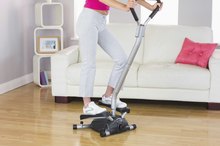How to Dissolve Blood Clots With Exercise
Blood clots occur when your blood transitions from a liquid to a solid. This is a dangerous occurrence because a blood clot can break off from a vein and travel to the heart or lung, which can result in death. Exercising frequently is vital to blood clot prevention and treatment. This is because exercise stimulates a process known as fibrinolysis, where enzymes that break down a clot are released, according to the American College of Sports Medicine (ACSM) 1. Those who exercise regularly are less likely to experience blood clots while those who do not increase their likelihood because blood can pool in the body’s deep veins, particularly the legs.
If you are experiencing serious medical symptoms, seek emergency treatment immediately.
Exercise on a stationary bicycle to encourage blood flow to the legs. According to the ACSM, stationery cycling performed in moderation can be beneficial to reducing and preventing blood clots. If you do not currently exercise, start slowly and work your way up in time and intensity.
How to Strengthen the Patella Tendon
Learn More
Walk 30 minutes each day, according to Pacific Nutrition Wellness. Walking is a low-impact activity that keeps you mobile and encourages circulation in the lower body. If your activity level does not permit exercising for 30 minutes, try walking at least five minutes every hour you are awake.
Perform ankle circles to increase circulation in your lower body. While seated, straighten one leg and rotate your foot in one direction for 25 to 30 circles. Reverse to perform the circles on the opposite direction. Lower this leg and repeat on the other leg. Perform an additional set of exercises on each leg.
How to Reduce Excess Fat on Hip & Thighs Fast
Learn More
Contract your calf muscles to rise on the balls of your feet. Calf raises help to boost circulation and can be performed almost anywhere. Lower and repeat 15 to 20 times. Rest and then repeat for two additional sets. Repeat two additional times throughout the day.
Warnings
If you have been diagnosed with blood clots and are taking blood thinners, avoid contact sports that put you at a higher bleeding risk, according to the National Blood Clot Alliance. This includes football, hockey, soccer, gymnastics, boxing, basketball or skiing. Replace these activities with non-contact exercises, such as walking, swimming or biking. If you are pregnant and have been diagnosed with blood clots, exercise may not be recommended. Speak with your physician about your exercise options, according to FamilyEducation.
Related Articles
References
Writer Bio
Rachel Nall began writing in 2003. She is a former managing editor for custom health publications, including physician journals. She has written for The Associated Press and "Jezebel," "Charleston," "Chatter" and "Reach" magazines. Nall is currently pursuing her Bachelor of Science in Nursing at the University of Tennessee.








